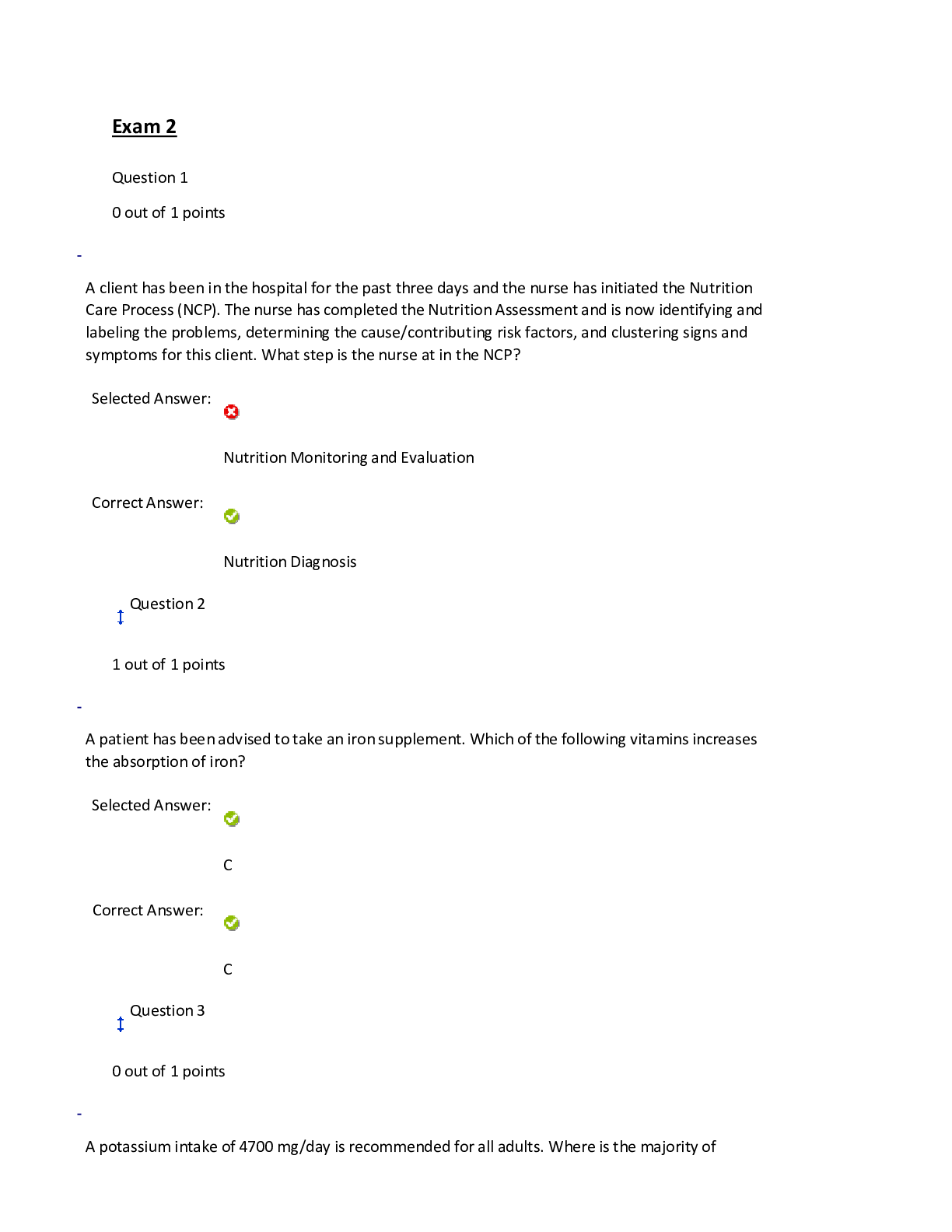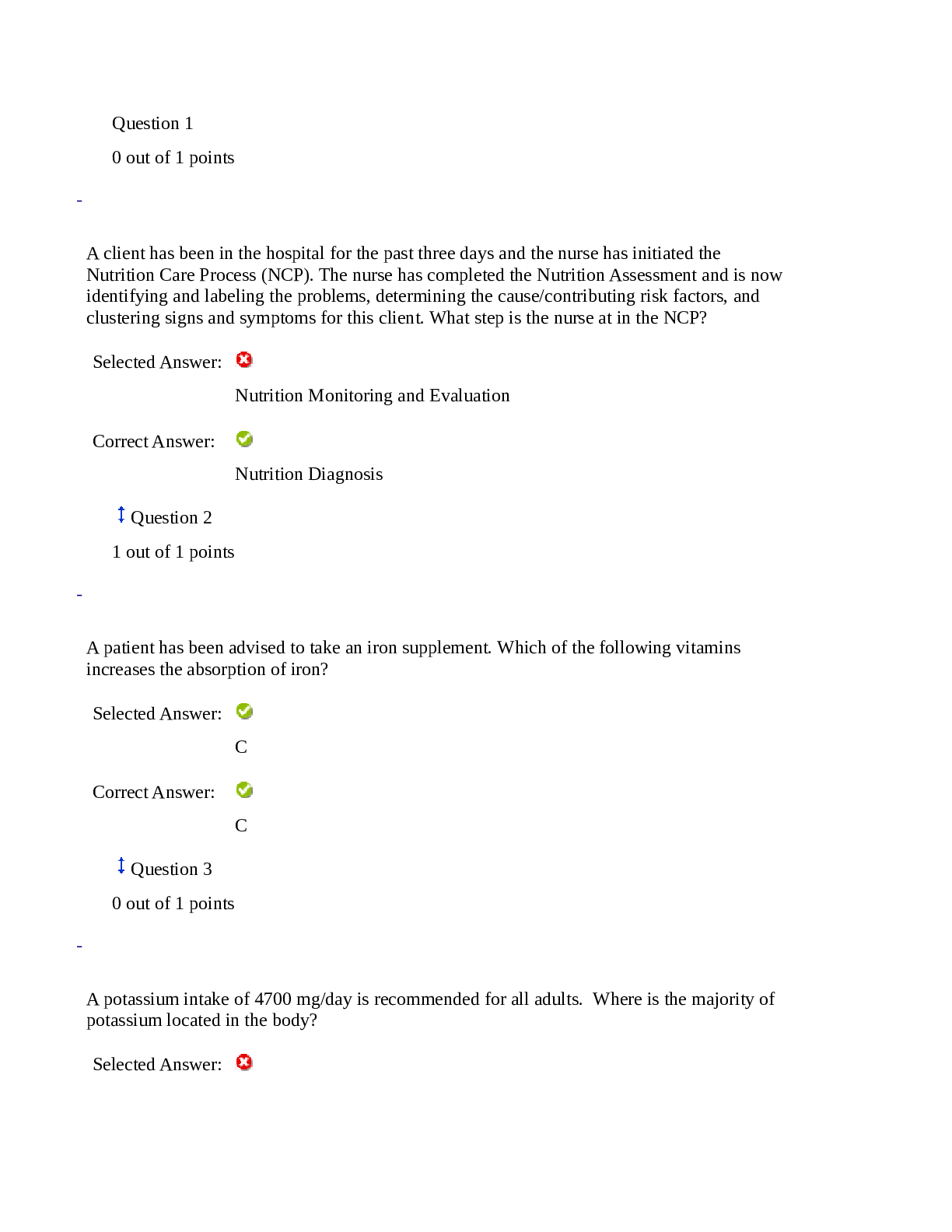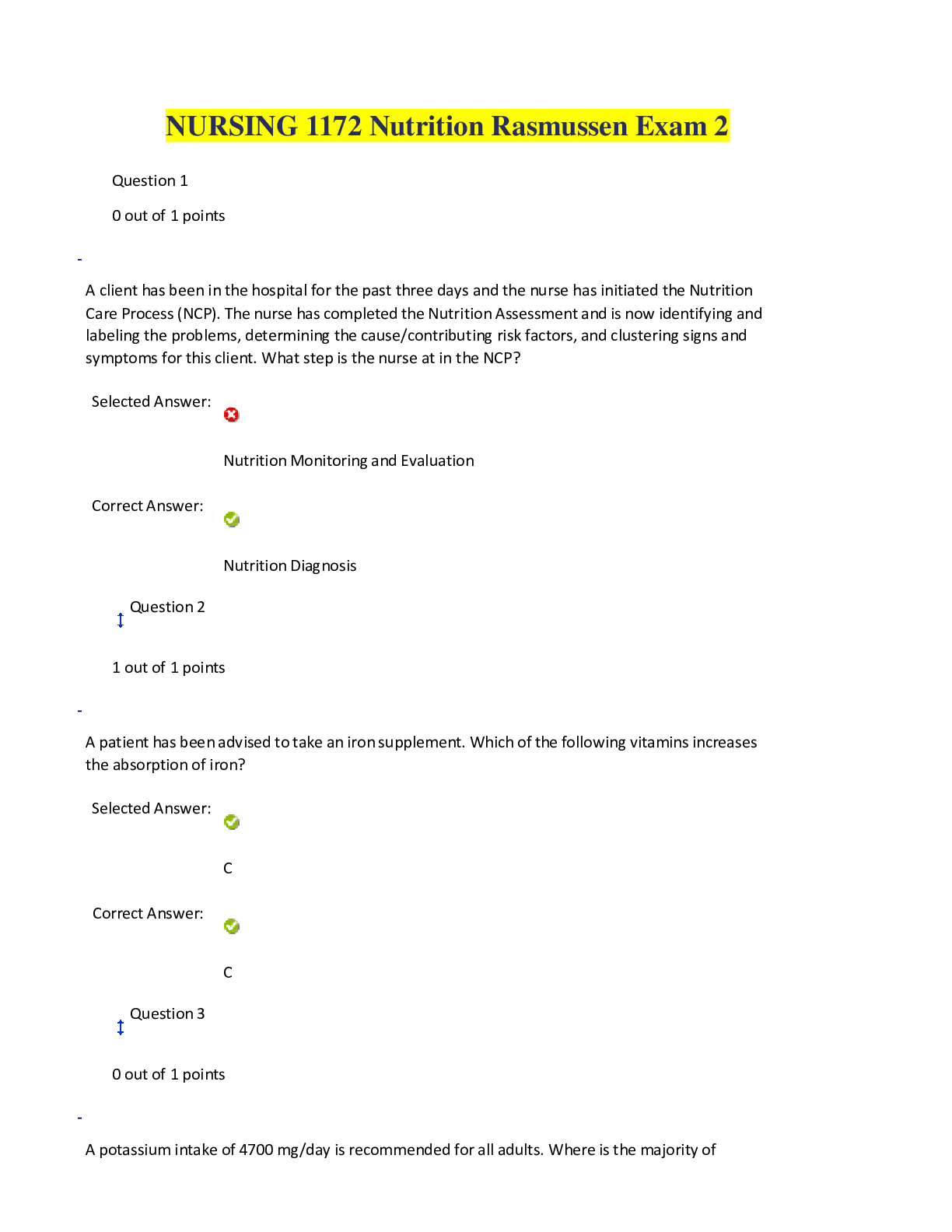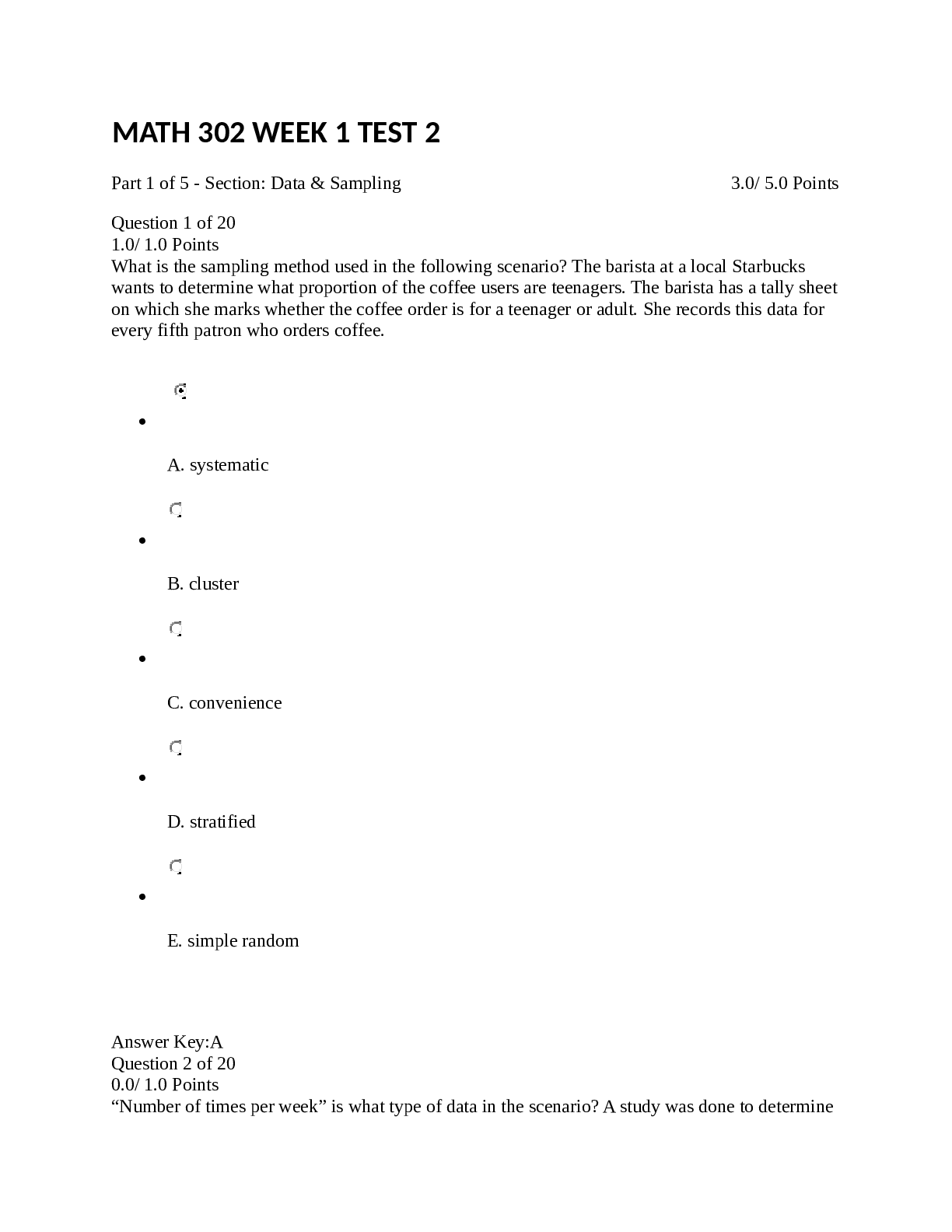*NURSING > EXAM > NURS 1172 Nutrition Study guide Test 2 - Rasmussen College (100%) / NURS 1172 Nutrition Study guide (All)
NURS 1172 Nutrition Study guide Test 2 - Rasmussen College (100%) / NURS 1172 Nutrition Study guide Test 2
Document Content and Description Below
NURS 1172 Nutrition Study guide Test 2 - Rasmussen College (100%) Chapter 1: • Government agencies - The United States Department of Health and Human Services was introduced to establish scient... ific-based, national objectives for promoting health. It includes many nutrition-related goals pertaining to dietary intake, maternal, and child health, and management of chronic disease. - The US Department of Agriculture (USDA) is a cabinet-level agency that oversees the American farming industry. Their duties range from helping farmers with price support subsides to inspecting food to ensure the safety of the American public. The USDA also sets about our dietary guidelines, such as the DRIs. - The US Food and Drug Administration (FDA) is responsible for protecting the public health by assuring the safety, efficiency, and security of human/veterinary drugs, biological products, medical devices, national food supply, cosmetics, and products that emit radiation. This department regulates food safety and labels, and also helps to educate the public of nutrition. • Guides - The USDA issued its first food guide in 1940s, and food guides evolved over time into various formats and shapes. The Food Guide Pyramid, modified to MyPyramid, was the graphic used to encourage healthy eating. The relative amount of food to be eaten from each food group was expressed by the width of that section of the pyramid. - MyPlate illustrates the five major food groups using a familiar mealtime visual – a place setting. The general themes of MyPlate are (1) eat small portions, and (2) choose lower calorie, nutrient-dense foods. • Evidence based practice (EBP) - EBP is the use of current research and findings that has been backed up by scientific evidence to make appropriate decisions. EBP guides are decisions in the nursing field. Includes 3 steps, identify the evidence, review the evidence, and implement the findings. • Function of nutrients - Nutrition means to nourish and encompasses the food people eat and how it enriches their lives physically, socially, and personally. Nutrients have three general functions: to provide energy, to build and repair body tissues and structures, and to regulate metabolic processes that maintain homeostasis. Chapter 6: • What are vitamins? Vitamins are complex molecules that are needed in very minute amounts, but are essential to certain tissues. To be classified as a vitamin, a compound has to meet several criteria: - It must be an organic dietary substance that is not energy producing. - It is needed in very small quantities to perform particular metabolic functions and prevent an identified deficiency disease. - It cannot be synthesized by the body, so it must be supplied in food. • Water – soluble vitamins – The water soluble vitamins are vitamin C and the B- complex family. These vitamins are easily absorbed and transported, but unlike the fat-soluble vitamins, they cannot be stored except in the general sense of tissue saturation. The B vitamins function mainly as coenzyme factors in cell metabolism, while Vitamin C works with enzymes that support tissue building and maintenance. 1. The discovery of Vitamin C is associated with the ancient hemorrhagic disease scurvy. Vitamin C is a powerful antioxidant and also functions to build and maintain many body tissues including matrix, cartilage, dentin, and collagen. Vitamin C is also found in greater amounts in metabolically active tissues such as the adrenal and pituitary glands, brain, eyes, and WBCs. Clinical Applications include wound healing, infection and fever, growth, and stress and body response. The best know sources of Vitamin C are citrus fruits, tomatoes, broccoli, salad greens, strawberries, watermelon, cabbage, and sweet potatoes. Because vitamin C is easily oxidized when exposed to air or heat, storage and preparation/cooking methods must be chosen carefully. Increased intake of Vitamin C has been shown to cure common cold, protect against degenerative disease, and delay signs of aging. Some adverse interactions of inappropriate supplement use can involve gastrointestinal symptoms and diarrhea. • Fat-soluble vitamins – Fat-soluble vitamins are A, D, E, and K. They are closely associated with body lipids and are easily stored. Their functions are usually related to structural activities with proteins. All fat-soluble vitamins are absorbed in the small intestine as part of the micelles. 1. Vitamin A is the generic name for a group of compounds with similar biologic activity: Retinol, Retinal, and Retinoic Acids. The term retinoid refers to the natural forms of vitamin A and its synthetic copy. There are two dietary forms of Vitamin A (1) preformed vitamin A and (2) Provitamin A. - Preformed Vitamin A (retinol): This is the natural form of vitamin A and can only be found in animal foods that are usually associate with fat. You can get this vitamin through dairy foods, egg yolk, liver, and fish. - Provitamin A vitamins can be found in broccoli, carrots, spinach, cantaloupe, tomato juice, and apricots. The role of Vitamin A in vision is best known, but vitamin A also influences the integrity of body coverings and linings (epithelial tissues), cell division, and differentiation, growth, immunity, and reproductive function. Deficiency in Vitamin A can cause night blindness, cell keratinization (cells become flat and dry rather than soft and moist), the cornea can dry and harden, respiratory - - - - - - - - - - - - between nose and lip), darkening and peeling of skin in areas exposed to the sun, and poor wound healing. - Nails: Spoon-shape nails, brittle, and fragile. - Heart: Enlargement, tachycardia, failure, small heart, sudden failure, death, arrhythmia, and hypertension - Abdomen: hepatomegaly or ascites - Musculoskeletal Extremities: Muscle wasting (especially in temporal area), edema, calf tenderness, breading of ribs or “rachitic rosary,” bone and joint tenderness, and knock knee, bowed legs, fragile bones. - Neurological: Paresthesia (pain and tingling or altered sensation in the extremities), weakness, ataxia, decreased position and vibratory senses, tremor, decreased tendon reflexes, confabulation, disorientation, drowsiness, lethargy, and depression. • Nutrition for hospitalized patients - Modes of feeding o Oral – As long as possible, of course, regular oral feeding is preferred. Supplements are added if needed. Depending on the patient, they may need assistance in eating. o Enteral nutrition and tube feeding. If a patient is unable to eat but the GI tract can be used, enteral delivery, or tube feeding, may provide needed nutrition support. A number of commercial formulas are available. o Peripheral nutrition – If the patient cannot take in food or formula via the GI tract, intravenous feeding is used, Solutions of dextrose, amino acids, vitamins, and minerals, with lipids as appropriate, can be fed through peripheral veins when the need is not extensive or long-term. o Total Parenteral Nutrition (TPN) – If the patient’s nutritional need is great and support therapy may be required for a longer time, parental feeding through a large central vein is needed. Placement of this catheter is a special procedure. More concentrated special solutions can be used and monitored by a nutrition support team. Formulas are determined by the dietitian and physician, and are prepared by trained pharmacists. • Types of Diets o Routine/House Diet o Nothing By Mouth (NPO) o Clear liquid o Full liquid - See Table 16-5 pg.375 [Show More]
Last updated: 1 year ago
Preview 1 out of 17 pages
Instant download
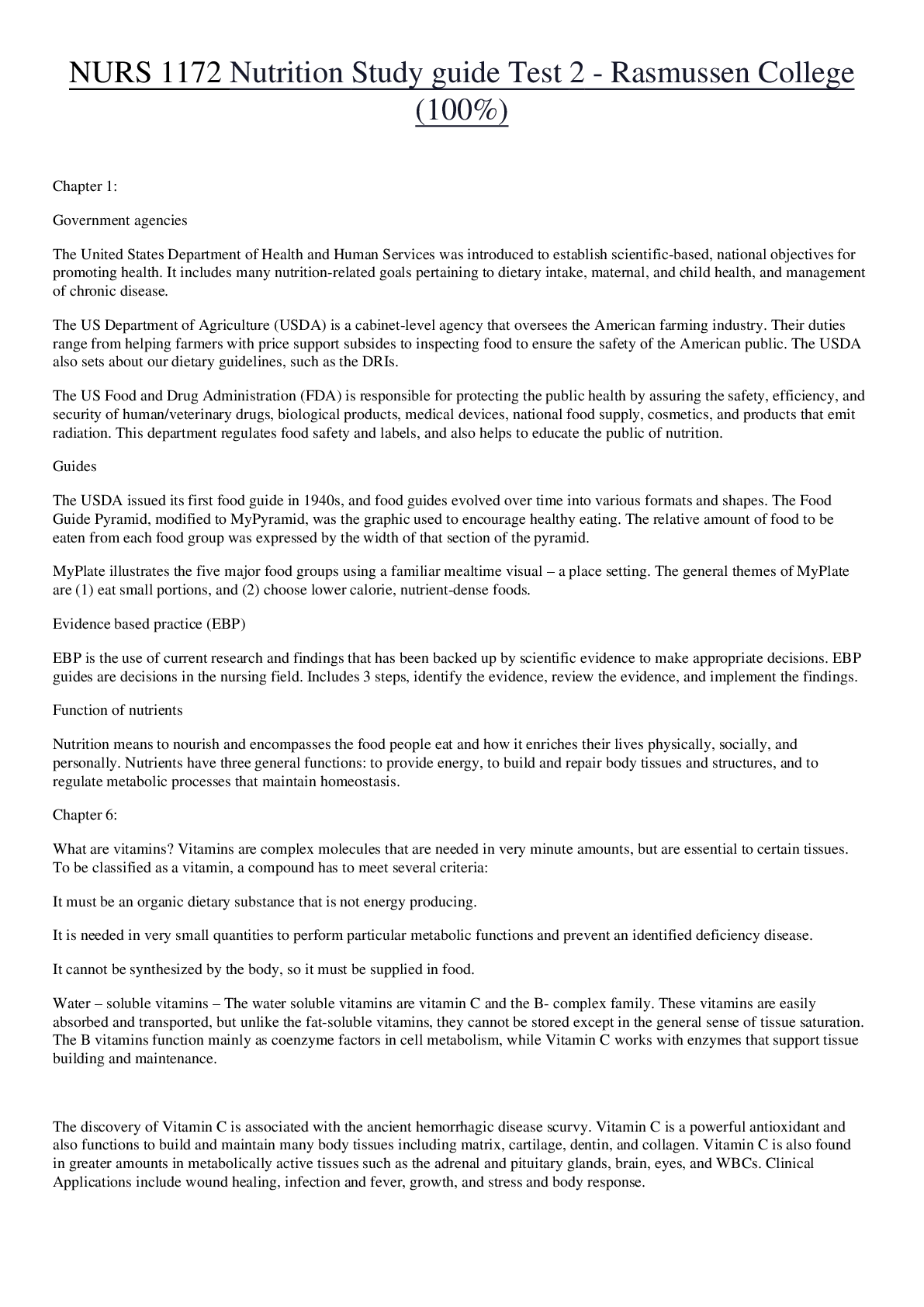
Buy this document to get the full access instantly
Instant Download Access after purchase
Add to cartInstant download
Reviews( 0 )
Document information
Connected school, study & course
About the document
Uploaded On
May 29, 2020
Number of pages
17
Written in
Additional information
This document has been written for:
Uploaded
May 29, 2020
Downloads
0
Views
28














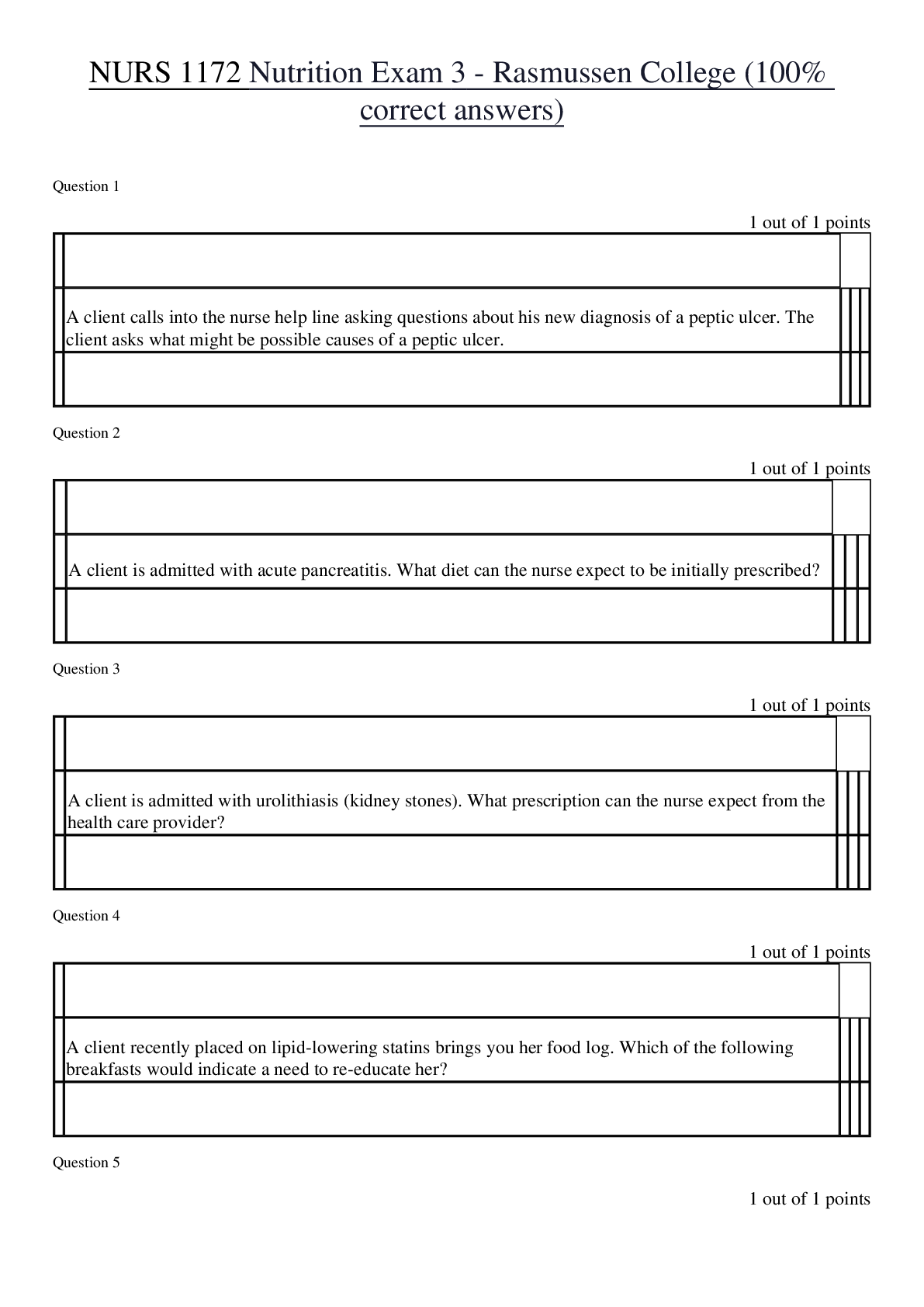

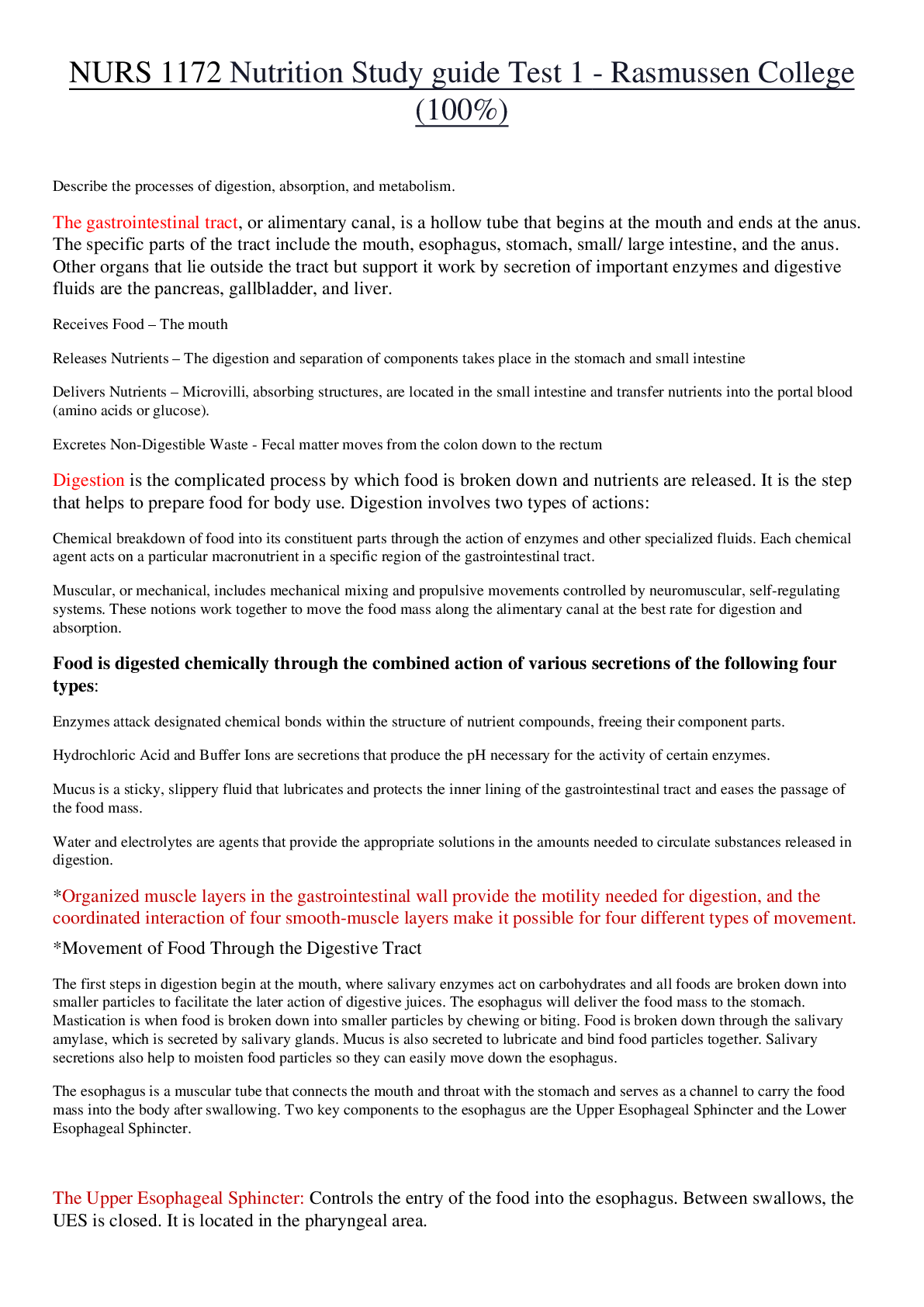
.png)
